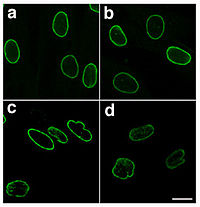
Photo from wikipedia
In gram‐negative bacteria, the ABC transporter LolCDE complex translocates outer membrane‐specific lipoproteins (Lpp) from the inner membrane to the outer membrane. Lpp possessing aspartate (Asp) at position +2 are not… Click to show full abstract
In gram‐negative bacteria, the ABC transporter LolCDE complex translocates outer membrane‐specific lipoproteins (Lpp) from the inner membrane to the outer membrane. Lpp possessing aspartate (Asp) at position +2 are not translocated because it functions as a LolCDE avoidance signal. In gram‐positive bacteria, lacking an outer membrane and the Lol system, Lpp are only anchored at the outer leaflet of the cytoplasmic membrane. However, the release of Lpp particularly in pathogenic or commensal species is crucial for immune modulation. Here, we provide evidence that in Staphylococcus aureus Asp at position +2 plays a role in withholding Lpp to the cytoplasmic membrane. Screening of published exoproteomic data of S. aureus revealed that Lpp mainly with Gly or Ser at position +2 were found in exoproteome, but there was no Lpp with Asp+2. The occurrence of Lpp with Asp+2 is infrequent in gram‐positive bacteria. In S. aureus USA300 only seven of the 67 Lpp possess Asp+2; among them five Lpp represented Lpl lipoproteins involved in host cell invasion. Our study demonstrated that replacing the Asp+2 present in Lpl8 with a Ser enhances its release into the supernatant. However, there is no different release of Asp+2 and Ser+2 in mprF mutant that lacks the positive charge of lysyl‐phosphatidylglycerol (Lys‐PG). Moreover, substitution of Ser+2 by Asp in SitC (MntC) did not lead to a decreased release indicating that in staphylococci positions +3 and +4 might also be important for a tighter anchoring of Lpp. Here, we show that Asp in position +2 and adjacent amino acids contribute in tightening the anchoring of Lpp by interaction of the negative charged Asp with the positive charged Lys‐PG.
Journal Title: MicrobiologyOpen
Year Published: 2017
Link to full text (if available)
Share on Social Media: Sign Up to like & get
recommendations!